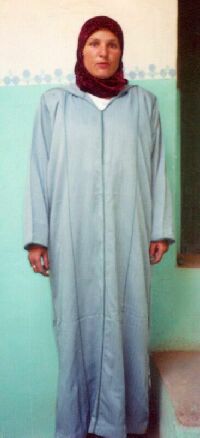
Marrakesh Express
Women Weavers OnLine
N'kob and Neighbors
Reminder: All prices include insured airmail shipment from Morocco.

This is Jamila, one of the master weavers, in her courtyard, dressed as she would be to go out. In an earlier photo here you saw her dressed to work at home, but when going out women wear this long robe called a jellaba. It's very convenient, rather like a light coat. Instead of worrying about what to wear out today, you can just throw it on over anything, even pajamas, and be ready to go. Notice the lovely colors and subtle design of the paint behind her shoulders. Most homes just have two plain colors on the walls, and I wonder if the additional decoration here was suggested by the weavers. It was done by Jamila's brother Si Brahim, who is president of the village development association and also paints houses.
Piece 1.10905 was made by Jamila and is called a Glawa. It combines knots, flatweave and a technique called twining that you see in the zig-zag bands above and below the hand here. As far as I know, rugs using these three styles of weaving are unique to southern Morocco. Click on the photo to see the rug overall, and here to see an enlarged close-up. Blue predominates in the center of the rug and a rich red at the ends. It measures 5'6" x 8'8" and the price is $720.
This is a N'kob woman who has enjoyed a long life of weaving. She thinks she is 80 years old but has no record, since (even today) in isolated villages many babies are born at home. She described learning to weave when she was 10 or 12, and how she used to use natrual dye from plant flowers and roots. For example in the piece on the loom the red would have been made from madder root, and the blue from indigo. She says she hasn't used natural dyes for the last 15 years. She is Rehma's mother-in-law, and may have made the long chedwi shown earlier after Rehma's photo, since the colors on her loom here are similar and we saw that piece in her home. She is also the mother of Aicha, one of the women leaders in the village, who is one of the few who knows how to use natural dyes.
Here is another expert weaver, this time in a village to the east of Ouarzazate. Her name is Lalla Fanna, and she is one of the women leaders trained by the Near East Foundation. In the photo she is spinning cotton, which you can see better by clicking on the photo. (When you do that you will notice blue marks between her eyebrows and on her chin. These are tatoos and in her youth were applied as "beauty marks." They aren't in style any more, so young women do not have them.) Some cotton is grown in northern Morocco, and she uses either that - or - cotton wadding bought at the pharmacy. She uses it in combination with natural white wool to make flatwoven pieces that can be used as blankets, fabric for men's cloaks (called jellabas) or women's capes (hendiras). You can see a bit behind her on the loom.
This is a closer view of the fabric Lalla Fanna is weaving. Notice the contrast in the two whites, and also how the cotton is not smooth but nubbled, to give another subtle contrast to the fabric. Clicking the photo shows great detail. If you click here you can see another example of this kind of fabric, with the white cotton lines in a varied pattern and highlighted by thin lines of rayon. The wooden object is a spindle, used to spin cotton and wool into yarn for weaving. I've never seen a spinning wheel in a home here. These fabrics are not being held for sale now, but if you would like something like this made to order, let me know and I can arrange it. The fabric is quite long, and takes Lalla Fanna between a month and a month and a half to weave, and she works full time because her family handles the household duties. A piece like this, about 5' x 9', would cost about $225. However, that's a very general estimate (including shipping from Morocco) and you can email me for more information if you are interested.
Here are some of the best weavers in the village of Zawiyat Tidgheste, Lalla Fanna among them. If you request something woven to order, most likely one of them will make it. In addtion, their village has worked with the Near East Foundation for several years and developed many projects. A recent one promoted by the Village Development Association is a museum in the village - in fact, the women in the photo are standing in front of the museum. It contains older weaving and household items for display, plus new woven items for sale. The secretary general of the Development Association is a teacher, and he has encouraged some of the village girls and young women to do small paintings which they sell there too. The village is only about 20 minutes from Ouarzazate, a popular tourist destination, so you might want to drop in if you go to Morocco. Email me for contact phone numbers and directions.